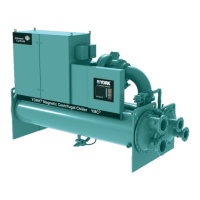JOHNSON CONTROLS
28
FORM 160.84-OM1
ISSUE DATE: 9/21/2017
SECTION 3 - OPTIVIEW™ CONTROL CENTER FUNCTIONS AND NAVIGATION
2. If the dialog box begins with the word “ENTER”,
use the numeric keys to enter the desired value.
Leading zeroes are not necessary. If a decimal
pointisnecessary,pressthe‘•’key(i.e.45.0).
Pressingthe▲key,setstheentryvaluetothede-
faultforthatsetpoint.Pressingthe▼key,clears
thepresententry.The◄keyisabackspacekey
and causes the entry point to move back one space.
If the dialog box begins with “SELECT”, use the
◄and►keystoselectthedesiredvalue.
If the previously defined setpoint is desired, press
the "X" (Cancel) key to dismiss the dialog box.
3. Press the "" (Enter) key.
If the value is within range, it is accepted and the
dialog box disappears. The chiller will begin to
operate based on the new programmed value. If
out of range, the value will not be accepted and
the user is prompted to try again.
Manual Controls
Some keys are used to perform manual control func-
tions. These may involve manual control of items such
as the compressor speed or valve actuators. These are
typically restricted to qualified technicians in Service
access. Other keys in this category are used to initiate/
terminate processes such as calibrations or reports.
Free Cursor
On screens containing many setpoints, a specific “soft”
key may not be assigned to each setpoint value. A soft
key will be assigned to enable the cursor arrow keys
below the numeric keypad which are used to “high-
light” the desired setpoint field. At this point, the ‘’
key is pressed to bring up a dialog prompting the user
to enter a new setpoint value. The ‘X’ key cancels cur-
sor mode. (See the Schedule Screen for an example.)
NAVIGATION
In order to maximize the amount of values which the
panel can display to the user, and in order to place those
values in context, multiple screens have been designed
to describe the chiller operation. In order to move from
one screen to the next, navigation keys have been de-
fined. These keys allow the user to either move “for-
ward” to a subscreen of the present screen, or move
“backward” to the previous screen. Except for the
Home Screen display, the upper-right “soft” key will
always return the user to the Home Screen. Navigating
with “soft” keys is as simple as pressing the key next
to the label containing the name of the desired screen.
The system will immediately refresh the display with
the graphics for that screen. Following is a layout of all
the screens and how they are connected.
Home Screen (Page 30)
System Screen (Page 32)
Evaporator Screen (Page 34)
Condenser Screen (Page 36)
Heat Pump (Page 38)
Compressor Screen (Page 41)
Magnetic Bearing Controller Screen (Page 43)
MBC Details Screen (Page 45)
Surge Screen (Page 47)
Variable Geometry Diffuser Screen (Page 49)
Power Panel Screen (Page 50)
Capacity Controls Screen (Page 52)
VSD Screen (Page 54)
VSD Details Screen (Page 56)
Motor Details Screen (Page 58)
Setpoints Screen (Page 60)
Setup Screen (Page 62)
Schedule Screen (Page 65)
User Screen (Page 67)
COMMS Screen (Page 68)
Printer Screen (Page 69)
Sales Order Screen (Page 70)
Operations Screen (Page 72)
History Screen (Page 73)
History Details Screen (Page 75)
Custom Screen (Page 76)
Custom Setup Screen (Page 77)
Trend Screen (Page 78)
Trend Setup Screen (Page 80)
Advanced Trend Setup Screen (Page 82)
Common Slots Screen (Page 84)

